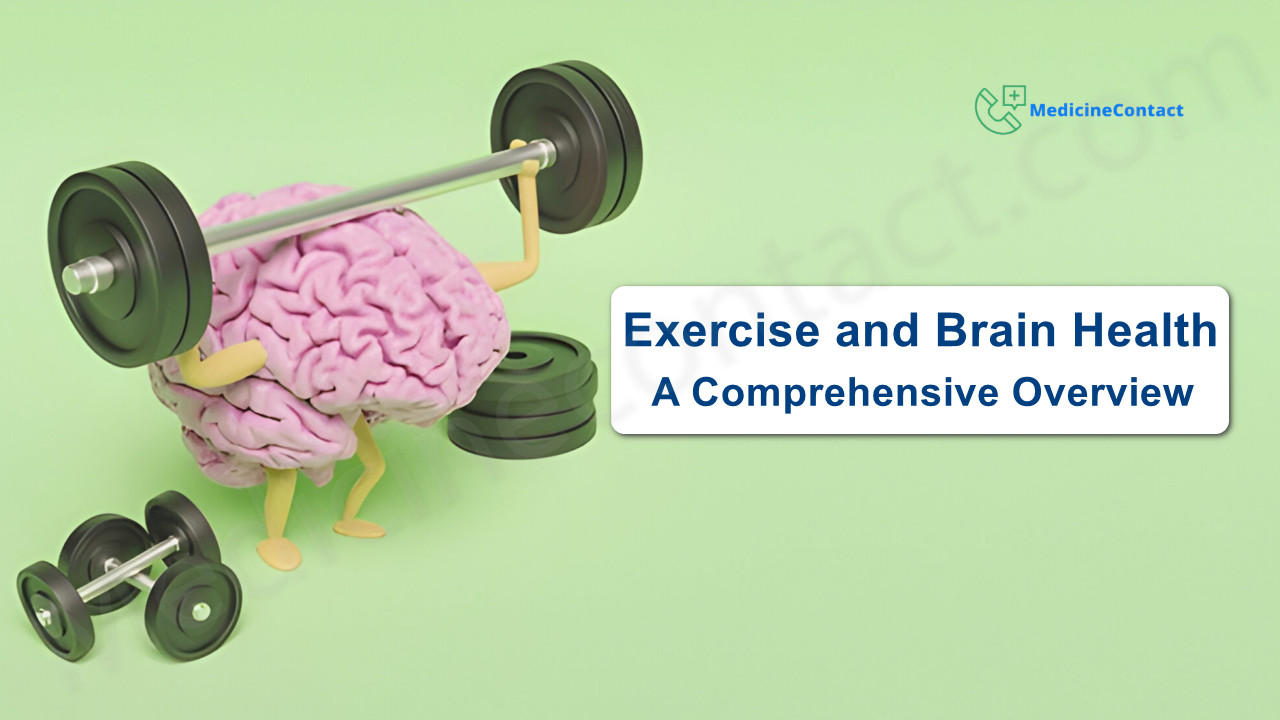
Introduction
Exercise is more than just a tool for physical fitness; it’s a powerhouse for mental well-being too. Engaging in regular physical activity can significantly enhance brain health, impacting everything from mood and concentration to overall cognitive function.
Understanding the connection between exercise and brain health is crucial for achieving optimal well-being. By delving into this relationship, readers will discover:
- How exercise influences brain function.
- The benefits of different types of exercises on mental health.
- Practical guidelines for incorporating exercise into daily routines for maximum brain health benefits.
By the end of this article, you’ll have a comprehensive understanding of how exercise can be a game-changer for your brain health. Whether you're curious about how many hours after exercise will your body continue to burn fat and sugar? or what the equation to calculate your BMI is, this guide has got you covered.
So, lace up those sneakers and get ready to explore the profound impact of physical activity on your mental well-being!
The Science Behind Exercise and Brain Function
Muscle-Brain Communication
Exercise is not just a physical activity; it actively engages the brain through a complex network of muscle tissue and nerve signals. As muscles contract and stretch, they send signals to the brain via the nervous system. This muscle-brain communication helps improve coordination, balance, and overall cognitive function.
Hormones and Neurotransmitters
The role of hormones and neurotransmitters in cognitive enhancement is profound. For example, irisin, a hormone released during physical activity, has been shown to promote brain health by boosting neuron survival and growth. Additionally, exercise stimulates the release of neurotransmitters like serotonin and dopamine, which are crucial for mood regulation, concentration, and alertness.
Neurogenesis
One of the most fascinating aspects of exercise is its ability to promote neurogenesis, the process of generating new neurons. Physical activity stimulates the production of brain-derived neurotrophic factor (BDNF), a protein that supports the survival of existing neurons and encourages the growth of new ones. This process is particularly beneficial for areas of the brain associated with memory and learning, such as the hippocampus.
Any personal training plan should be developed using the FITT principles of exercise—Frequency, Intensity, Time, and Type—to maximize these benefits. By incorporating regular physical activity into your routine, you can enhance both your physical fitness and cognitive well-being.
Benefits of Exercise on Mental Health
Enhancing Mood and Concentration
Regular physical activity significantly enhances mood and concentration. Exercise triggers the release of endorphins, often termed as "feel-good" hormones, which elevate mood and promote a sense of well-being. Moreover, physical fitness activities increase blood flow to the brain, improving cognitive functions such as concentration and memory.
Impact on Anxiety and Depression Symptoms
Exercise serves as a powerful tool in combating anxiety and depression. Engaging in physical fitness activities helps reduce stress levels by lowering cortisol, the body's primary stress hormone. Additionally, the production of serotonin during exercise acts as a natural antidepressant, alleviating symptoms of depression and anxiety.
Boosting Self-Esteem
Physical activity is closely linked to improvements in self-esteem. Achieving fitness goals contributes to a positive self-concept and body image. By enhancing one's physical capabilities, exercise fosters a sense of accomplishment and confidence.
Consider these key components of fitness:
- Cardiovascular Endurance: Improves heart health and stamina
- Muscular Strength: Enhances muscle power
- Muscular Endurance: Increases the ability to sustain physical activity over time
- Flexibility: Promotes joint health and range of motion
- Body Composition: A healthy balance between fat and muscle mass
Integrating these components into a regular fitness routine can lead to substantial mental health benefits.
Different Types of Exercises and Their Impact on Brain Health
Aerobic vs. Anaerobic Exercises
Aerobic exercises are activities that increase your heart rate and breathing over extended periods. They include:
- Walking
- Running
- Bicycling
These exercises enhance cardiovascular fitness, which in turn improves oxygen supply to the brain, supporting cognitive functions like memory and attention.
Anaerobic exercises, on the other hand, are short bursts of intense activity. Examples include:
- Weight lifting
- Sprinting
- High-intensity interval training (HIIT)
Anaerobic exercises focus on building muscular strength and endurance by requiring the muscles to work intensely for brief periods.
Improving Muscular Strength and Endurance
For those wondering which exercises are best for improving muscular strength and endurance, push-ups are an excellent choice. Unlike walking or running, push-ups specifically target muscle groups, enhancing both strength and endurance.
Mark has been participating in a vigorous exercise routine but noticed a plateau in his gains. Two suggestions to help Mark continue improving his strength could include:
- Varying his workout routine: Incorporating different types of exercises can prevent muscle adaptation.
- Increasing resistance or intensity: Gradually adding weights or increasing intensity can stimulate further muscle growth.
Unique Contributions to Cognitive Function
Different types of exercises contribute uniquely to cognitive function:
- Aerobic exercises: Improve overall brain function by enhancing blood flow and oxygenation.
- Anaerobic exercises: Boost hormone production that supports neurogenesis—the creation of new neurons.
Incorporating a balanced mix of both aerobic and anaerobic activities is crucial for optimizing brain health and cognitive performance.
Assessing Muscular Strength and Endurance Tests: Curl-up vs. Arm Hang Test
Understanding Physical Activity vs. Exercise
Physical activity and exercise often get used interchangeably, but they are distinct concepts.
- Physical Activity: Any bodily movement produced by skeletal muscles that require energy expenditure, such as walking, gardening, or even household chores.
- Exercise: A subset of physical activity that is planned, structured, and repetitive with the objective of improving or maintaining physical fitness.
For instance, taking the stairs instead of the elevator counts as physical activity, while a 30-minute session at the gym qualifies as exercise.
Muscle Strength Assessment Tests
Assessing muscular strength and endurance helps in evaluating an individual's physical fitness. Among various tests available, the curl-up test and arm hang test are commonly used.
Curl-up Test
The curl-up test measures abdominal strength and endurance. Participants lie on their back with knees bent and arms at their sides. The goal is to perform as many curl-ups (similar to sit-ups) as possible within a set time limit.
Advantages:
- Simple to administer.
- Requires minimal equipment.
- Can be performed individually or in groups.
Disadvantages:
- Focuses primarily on abdominal muscles.
- May not reflect overall muscular endurance.
Arm Hang Test
The arm hang test evaluates upper body strength and endurance, particularly in the arms and shoulders. Participants hang from a horizontal bar for as long as possible without touching the ground.
Advantages:
- Effective for assessing upper body strength.
- Useful for athletes who need strong upper bodies.
Disadvantages:
- Requires a horizontal bar.
- May be challenging for beginners or those with weaker upper body strength.
Compare and Contrast: Curl-Up vs. Arm Hang Test
Both tests assess muscular strength but target different muscle groups:
- Curl-Up Test: Abdominal muscles.
- Arm Hang Test: Upper body muscles.
These differences highlight why different muscle groups must be tested separately rather than using one test universally across all muscle areas.
Common Questions
- Which of the following is true about assessing muscular strength and endurance?
- a. All muscle groups can be tested simultaneously.
- b. Muscle strength and endurance are always assessed together.
- c. Different muscle groups have to be tested separately.
- d. One test can determine an individual's muscle group focus area.
- Which of the following tests uses calipers to assess body composition?
- a. Skinfold test
- b. Sit-and-reach
- c. Arm hang
- d. Curl-up
Each type of physical assessment has its own specific purpose and should be chosen based on what aspect of fitness you aim to evaluate. This ensures accurate results and targeted improvements in your exercise routine.
What Happens When Your Body "Hits a Wall" During Physical Activity?
Hitting a wall occurs when your body's glycogen stores deplete during prolonged physical activity, leading to sudden fatigue and loss of energy. This phenomenon underscores the importance of proper nutrition and energy management during exercise sessions.
Understanding these distinctions helps in designing effective fitness programs tailored to individual needs, ensuring comprehensive physical development without overemphasis on any single aspect.
Exercise Frequency, Duration, and Intensity for Optimal Brain Health Benefits
Understanding the right balance of frequency, duration, and intensity in exercise can significantly boost brain health. Following recommended guidelines ensures that workouts are both effective and sustainable.
Frequency:
Adults: Aim for 2.5-5 hours of moderate physical activity or 1.25-2.5 hours of vigorous activity per week. Children and Adolescents: Engage in at least 60 minutes of physical activity daily.
Duration:
Session Length: Each workout session should last at least 30 minutes. Shorter sessions can be effective if they are intense enough to elevate the heart rate.
Intensity:
Moderate Intensity: Activities like brisk walking, cycling on flat terrain, or light dancing. Vigorous Intensity: Running, aerobics, or swimming laps.
The combination of these elements fosters cognitive enhancement through the release of hormones such as serotonin and endorphins, which improve mood and reduce stress levels. Regular physical activity also aids in neurogenesis — the formation of new neurons — particularly in brain regions associated with memory and learning.
Moreover, regular exercise changes the brain to improve memory and thinking skills, making it a vital component of cognitive health. Incorporating a variety of exercises like aerobic activities for cardiovascular health and strength training for muscle endurance further optimizes brain function. This holistic approach not only supports mental well-being but also enhances overall physical fitness.
Exploring the Role of Warm-Up in Exercise Routine for Brain Health Optimization
Benefits of Warming Up for Brain Health
Warming up before exercise is important not only for getting your body ready but also for boosting brain health. Here are three key benefits:
- Enhanced Blood Flow and Oxygen Supply:
- A proper warm-up increases blood flow, ensuring a rich supply of oxygen to the brain.
- This heightened oxygen availability supports cognitive functions, such as improved focus and mental clarity during and after exercise.
- Release of Neurotransmitters:
- Engaging in a warm-up routine triggers the release of neurotransmitters like dopamine and endorphins.
- These chemicals enhance mood, reduce stress levels, and prepare the brain for the mental demands of a workout.
- Improved Neural Activation:
- Warming up activates neural pathways, promoting better coordination and reaction times.
- This is particularly beneficial for exercises requiring precise movements and can help improve overall cognitive performance.
Incorporating these practices ensures that both your body and mind are primed for optimal performance during physical activities.
How Different Exercises Affect Your Brain and Metabolism
Certain types of exercises can significantly boost metabolism, which in turn enhances brain functionality. Here's how:
1. Aerobic Exercises
Examples: Running, swimming, cycling
These activities increase heart rate and oxygen intake, promoting cardiovascular health. Enhanced blood flow ensures a steady supply of oxygen and nutrients to the brain, thereby improving cognitive functions such as memory and concentration.
2. Anaerobic Exercises
Examples: Weightlifting, high-intensity interval training (HIIT)
Short bursts of intense activity stimulate muscle growth and strength. This leads to an increase in resting metabolic rate (RMR), allowing the body to burn calories more efficiently even when at rest. A higher RMR supports better mood regulation and cognitive sharpness.
3. Flexibility and Balance Training
Examples: Yoga, Pilates
These exercises may not drastically elevate metabolism but play a crucial role in stress reduction and mental clarity. By fostering relaxation and reducing cortisol levels, they contribute to an overall enhancement in brain health.
Incorporating a variety of these exercises into your routine can yield comprehensive benefits for both physical fitness and brain health. Regular engagement in these activities promotes neurogenesis and the release of beneficial neurotransmitters like serotonin and endorphins, directly linking physical exertion to enhanced mental well-being.
For further insights into specific tests like the curl-up or arm hang test for assessing muscular strength, check out Fitness News & Trends.
Psychological Benefits of Regular Exercise for Brain Health
Regular physical activity leads to numerous psychological benefits that significantly support brain health. One of the primary advantages is the improvement in mental clarity. After exercising, people often find it easier to focus and remember things. This mental boost happens because exercise increases blood flow to the brain, bringing more oxygen and nutrients that are crucial for the brain to work well.
Key Psychological Benefits:
- Enhanced Mood: Exercise stimulates the release of neurotransmitters like serotonin and endorphins, known for their mood-lifting properties.
- Reduced Anxiety and Depression: Engaging in regular physical activity has been shown to lower symptoms of anxiety and depression, providing a natural remedy for these conditions.
- Increased Self-Esteem: Regular exercise can improve body image and self-concept, leading to higher self-esteem.
Comparing muscle strength assessment tests like the curl-up test and arm hang test reveals that different tests target specific muscle groups and cannot be used interchangeably. Each test measures unique aspects of muscular strength and endurance:
- Curl-Up Test: Focuses on abdominal muscle strength.
- Arm Hang Test: Assesses upper body endurance.
Which of the following is true about assessing muscular strength and endurance?
- All muscle groups can be tested simultaneously.
- Muscle strength and endurance are always assessed together.
- Different muscle groups have to be tested separately.
- One test can determine an individual's muscle group focus area.
The correct answer is c. Different muscle groups have to be tested separately.
Additionally, assessing body composition often involves specific tests like the skinfold test, where calipers measure subcutaneous fat thickness.
Which of the following tests uses calipers to assess body composition?
- Skinfold Test
- Sit-and-Reach
- Arm Hang
- Curl-Up
The correct answer is a. Skinfold Test.
Understanding these assessments helps tailor exercise programs that effectively enhance both physical fitness and mental well-being, emphasizing the holistic impact of regular physical activity on brain health.
For more insights on fitness trends, visit Fitness News & Trends.
Medical Evaluations Related to Exercise Participation: Ensuring Safety in Brain Health-Focused Workouts
Before starting an exercise program to improve brain health, it's important to have certain medical evaluations. These assessments ensure that individuals can safely engage in physical activities without risking injury or negative health effects.
Key Medical Exams:
- Physical Activity Readiness Questionnaire (PQR-Q): This initial screening tool helps identify any potential risks associated with increased physical activity. It includes questions about medical history and current symptoms.
- Exercise Stress Test: Often conducted under medical supervision, this test evaluates cardiovascular response to physical stress. It is particularly useful for identifying heart-related issues that might be worsened by intense exercise.
- Medical Evaluation: Comprehensive assessments that cover various aspects of health, including cardiovascular, respiratory, and musculoskeletal systems. These evaluations are essential for tailoring exercise programs to individual needs and limitations.
- Lung Capacity Testing: During a medical screening, lung capacity testing measures the volume of air the lungs can hold and the efficiency of gas exchange. This is vital for understanding respiratory health and endurance capabilities.
Why Different Tests Cannot Be Used Interchangeably:
Muscle strength assessment tests such as the curl-up test and arm hang test target different muscle groups and serve distinct purposes:
- Curl-Up Test: Focuses on abdominal muscle strength and endurance.
- Arm Hang Test: Measures upper body strength, specifically targeting the arms and shoulders.
Different muscle groups have to be tested separately because each group has unique functional capabilities and endurance levels. Thus, one test cannot determine an individual's overall muscular strength or focus area.
Answering common queries:
- Which of the following is true about assessing muscular strength and endurance?c. different muscle groups have to be tested separately.
- Which of the following tests uses calipers to assess body composition?a. skinfold test.
- During a medical screening, lung capacity testing is a standard procedure.True.
By understanding these evaluations and their significance, individuals can better prepare for brain health-focused workouts while minimizing risks associated with physical exertion.
Conclusion: Prioritizing Regular Exercise for Optimal Brain Health Benefits!
Regular physical activity is essential for maintaining and improving brain health. As discussed in this article, the complex connection between exercise and brain function highlights the significant influence that physical fitness has on mental well-being.
Key points to remember:
- Improved Thinking Skills: Regular exercise helps create new brain cells, which enhances cognitive abilities.
- Better Mental Health: Physical activity greatly reduces symptoms of anxiety and depression while improving mood and focus.
- Various Exercise Benefits: Different types of exercises, such as cardio, strength training, and flexibility workouts, each contribute uniquely to brain health, emphasizing the importance of a well-rounded fitness routine.
Prioritizing physical activity not only strengthens the body but also fortifies the mind. For those committed to their overall well-being, understanding and leveraging the connection between exercise and brain health is crucial.
By making exercise a regular part of your life, you are investing in a healthier mind that can handle challenges with strength and clarity.
FAQs (Frequently Asked Questions)
How does exercise influence brain function?
Exercise influences brain function through muscle tissue and nerve signals, enhancing communication between muscles and the brain. This interaction is supported by hormones like irisin and neurotransmitters that promote cognitive enhancement.
What are the mental health benefits of regular physical activity?
Regular physical activity enhances mood and concentration, reduces stress, and is linked to decreased symptoms of anxiety and depression. Additionally, it can improve self-esteem by fostering a sense of achievement and well-being.
What is the difference between aerobic and anaerobic exercises?
Aerobic exercises are activities that increase your heart rate and breathing for an extended period, such as running or cycling, while anaerobic exercises involve short bursts of high-intensity effort, like weightlifting or sprinting. Both types contribute uniquely to cognitive function.
What is the recommended target heart rate for fat burning during exercise?
To reach a 'fat burning zone,' your heart rate should typically be around 60-70% of your maximum heart rate. This usually translates to about 120-150 beats per minute for most individuals, depending on age and fitness level.
How can I calculate my personal target heart rate?
To calculate your personal target heart rate, first determine your maximum heart rate by subtracting your age from 220. Then, multiply that number by the desired intensity percentage (usually between 60-85%) to find your target range.
What happens to the body after exercising in terms of fat burning?
After exercise, the body continues to burn fat and sugar for several hours. The duration can vary based on factors such as exercise intensity and individual metabolism, but it typically lasts anywhere from a few hours up to 24 hours post-exercise.
Disclaimer: This article is for informational purposes only and does not constitute medical advice. Always consult with a healthcare professional before starting any new treatment regimen.



